21 Types of roofs
Everyone wants a sound roof over their head, but many overlook the nuances of roofing design on the overall performance of an industrial, commercial or residential structure. Different roof types offer different performance, structural as well as aesthetic benefits that improve longevity, economy and comfort relative to the location of the building and the materials used. Understanding the different roofing styles can help to improve overall building design as well as improve the selection of materials to ensure an adequate roof. Below, we offer a brief review of 21 house roof types to help you get a better understanding of the relationship between the right roof and overall building performance.
Flat Roof
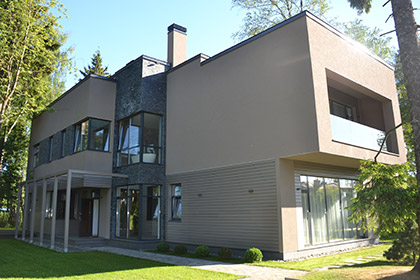
The flat roof is the most basic type of roof, essentially a flat and level top of a building. Flat roofs offer many advantages and disadvantages. Flat roofs are much easier to install and maintain because there is no incline to navigate. Further, flat roofs reduce the possibility of heat accumulation in an attic or upper building area. For ambitious gardeners, flat roofs can be converted into green roofs that allow plant beds to be installed. Flat roofs are not without their challenges, including the increased likelihood of water penetration due to more challenging water removal and the potential of ice buildup in colder climates.
Box Gable Roof
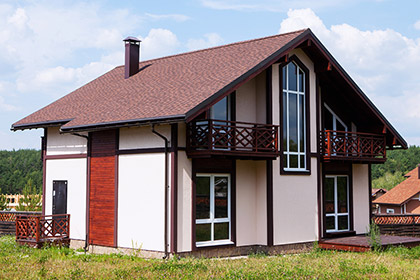
There are many types of gable roof designs, as will be demonstrated below. The box gable roof is distinct from other gable styles in that, where the two sides of the roof meet to form the traditional triangle of the gable roof, the edges of the roof are framed in to form an actual triangle. As with other gable roofs, the design is effective in directing the flow of precipitation, such as water and snow; the boxed-in end caps provide slightly more stability than other gable designs in strong wind.
Simple Hip Roof
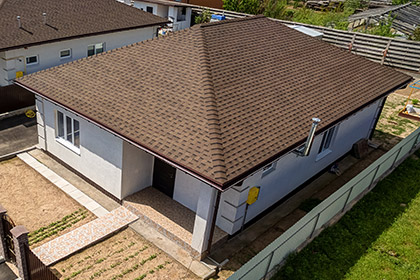
A simple hip roof features 4 angles portions of the roof that meet along the raised ridge of the roof with a continuous eave running round the edges of the roof. The hip roofing design offers many advantages, such as ease of gutter installation, high wind resistance, popular roofing aesthetic and extra living space. A hip roof is more expensive than a gable roof and does potentially increase the likelihood of leakage where the hips arise.
Hip and Valley Roof
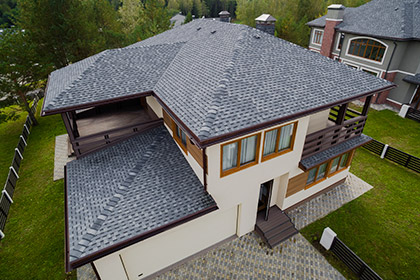
The hip and valley roof is when a gabled roof is divided into angle segments, often featuring a portion of the roof that runs perpendicular to each other. This forms the notable ridges and, where the two roofs join, valleys that angle down. Advantages of this design are increased wind resistance as well as gutter functioning, however, valleys are more prone to leaks and the overall home design is more expensive to build because of the increased flashing required to prevent leaking.
Gambrel Roof
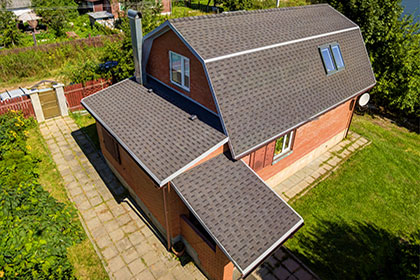
A gambrel roof is a modification of a gable roof with less steep symmetrical portions running from the peak of the roof into more steeper panels that end at the eaves of the roof. This design is most often associated with colonial building styles, particularly barns. Despite its antiquated appearance, this design allows fewer materials to be used to create more interior space while also maximizing drainage. As with other gable roofs, it is not as wind-resistant and can wear unevenly given the different slopes of the roof regions.
Front Gable Roof
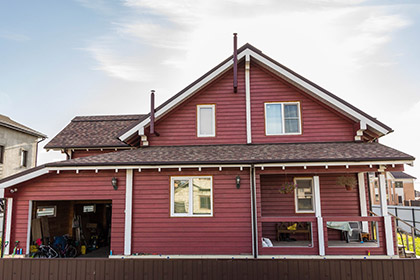
A front gable roof is a roof where the two planes of the roof meet in the middle to form an upside-down "v" that faces the front of the home. Gabled roofs are considered much easier to construct and maintain than other types of roofs, such as hip roofs, and are excellent at preventing the buildup of moisture and precipitation, particularly snow. As noted with other gable designs, the exposure of the two eaves of the roof decreases its wind resistance.
Mansard Roof
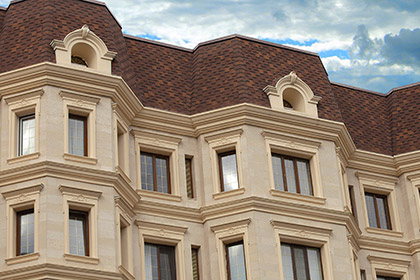
The mansard roof is a variation of the gambrel roof, with two distinct slopes on each side that feature dormer extensions that extend from the lower slope. It has similar advantages and disadvantages to the gambrel roof but emphasizes the functional space at the upper portion of the roof where the dormer roofs are embedded.
Parapet Roof
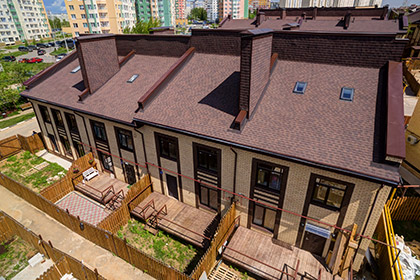
A parapet roof is effectively combining the clerestory, dormer and dome roofs into one section of the roof that rises above the rest of the roof and which features hexagonal, hip or similar roofing that joins to a peak. Aside from the distinct features of this roof, it can increase livable and storage space while also offering excellent wind and water resistance. Disadvantages include the cost of the extra roofing design as well as ensuring that the parapet will not be prone to leaks due to the increased exposure.
Open Gable Roof
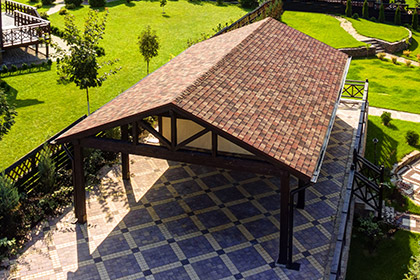
The open gable roofing design is similar to other gable roof designs where the two roof halves meet at a ridge and run along the length of the building without interruption. The distinction of the open gable roof is that it is not completely framed so that the interior space runs up the roof. This is desirable where a more open concept can be applied such as in a living room, dining room or other communal areas, but there will be an obvious reduction in storage space as well as the potential to increase indoor heating and cooling because of the direct contact with the roof surface.
Cross Hipped Roof
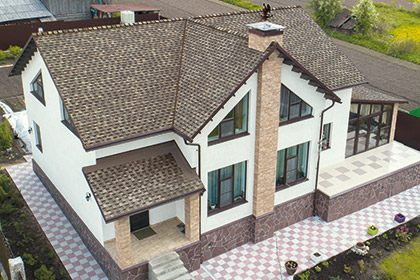
The cross-hipped roof is a variation of the hip roof, where the roof slopes away in each direction from the highest point of the roof, known as the hip. With the cross-hipped roof, two sections of the home adjoining perpendicular to each other lead the roof to meet in a perpendicular fashion so that the slopes running away from the meeting point appear to be a cross when viewed from above. Among the advantages of this roof design are its ability to resist high wind speeds and the ease of installing and managing gutters.
Dormer Roof
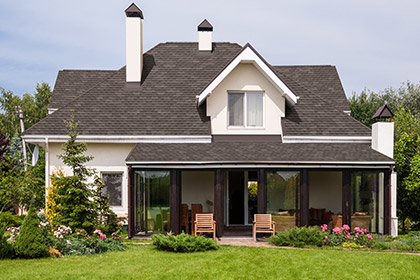
A dormer roof is a modification of the clerestory roof in that it is a portion of the roof that extends above the rest of the roof. It is a common roofing style for additions or for a residential apartment or home conversion settings where converting an upper attic or living space into a more functional space requires an elevated roof. Beyond the increased space, dormer roofs can improve lighting and ventilation. As with any roof, where there is greater exposure, it increases the risk of water and wind penetration where there is a division in roof continuity.
Dutch Gable Roof
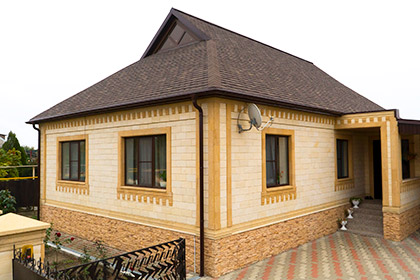
The Dutch gable roof combines the best of gable and hip roof designs. A gable extension is featured on top of a hip roof so that there is a greater elevation of the overall roof design. While this design may reduce attic storage space, it offers the possibility of extending the usable living space beneath the gable portion. This design effectively combines the increased stability and water removal of a hip roof with the increased space of a gable roof.
Saltbox Roof
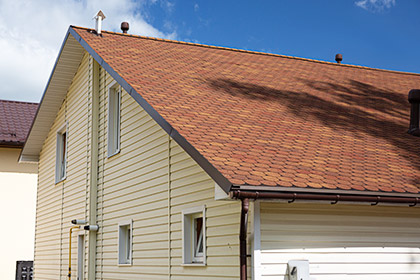
A saltbox roofing design is essentially a gabled roof where one side of the roof does not extend as far as the other. This design allows for integration with other features of the home, such as carports, garages or lower additions. Given that the home is not symmetrical with regard to the roof, part of the home may have a higher ceiling while potentially reducing indoor living space.
Clerestory Roof
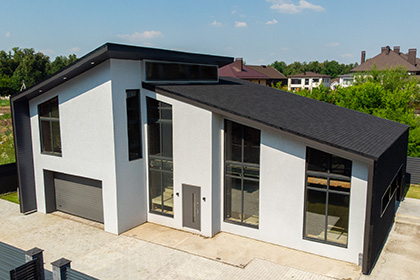
A clerestory roof is essentially two roofs in one, where the upper portion of the roof is separated by a short wall from the rest of the roof. This roofing design has various advantages that include improved natural light exposure, the potential for increasing natural ventilation in upper areas of a home, easier application of solar panels and increased upper-level space.
Half Hipped Roof
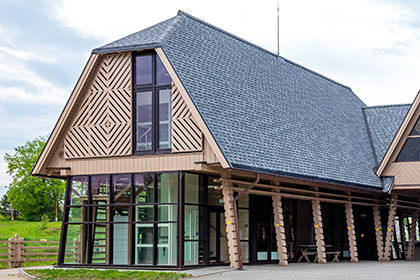
Also known as a jerkinhead roof, the half-hipped roof design partially modifies the gable roof with slight roof hips at either end of the gable. The half hips increase the roof's stability with regard to wind resistance, maintaining the ease and economy of the gabled roof. At the same time, half-hipped roofs result in slightly less usable space in the upper portions of the roof and can make installing ventilation systems more challenging because the half hips decrease space where ventilation systems can exhaust.
M-Shaped Roof
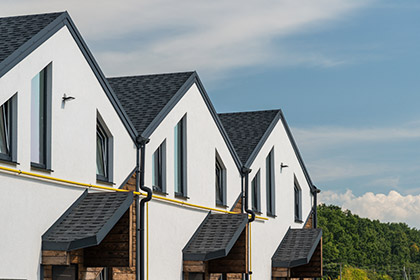
The M-shaped roof, also known as the sawtooth roof, features multiple sections of the roof where a vertical wall meets the roof pitch. This roof provides excellent opportunities for increasing natural lighting, particularly if these regions under the roof are utilized as living areas, but it is a more complicated roof to install because of the increased sections of the roof that are non-continuous. This roof can also be more prone to moisture penetration, particularly with regard to snow accumulation.
Curved Roof
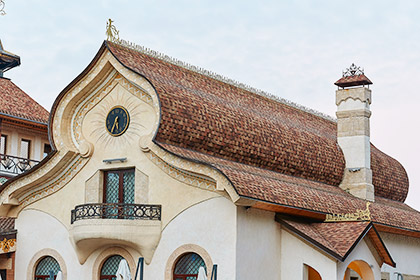
Once again, the name says it all. A curved roof is one where the underlying framing and sheathing of the roof form a gentle curving pattern when viewed from the side. This roofing style is a more modern design concept and popular as a reviewing design for smaller homes including cottages and bungalows. Beyond the distinct appearance of a curved roof, this design provides a welcome palette for green roofing materials that require a more sophisticated installation, such as metal roofs and specially designed shingles.
Dome Roof
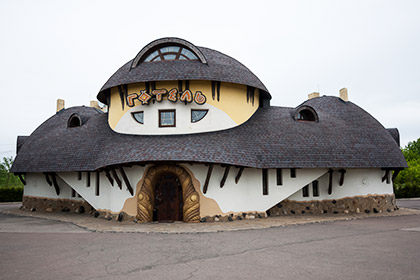
Dome roofs are a very antiquated building style, given that various buildings, including the Taj Mahal and the US Capitol building, feature domes. While domes feature prominently stone buildings, any home can include a dome roof that is shingled as well. Fire, water and wind resistance are more prominent when using stone as a building material, but all domed roofs offer exceptional water shedding as well as reduced heat buildup because of the reduction in exposed roof surfaces.
Bonnet Roof
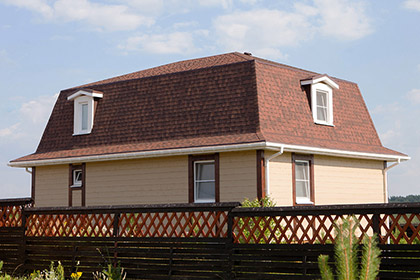
Also known as a balconette or a hip roof, the bonnet roof is shaped like a bonnet in that there are two slopes on the roof, with the upper portion being much steeper than the lower portion. The lower portion of the roof is typically featured as an eave that extends over the house, supported by beams, pillars or posts on at least the four corners of the roof. Although this type of roof is slightly more challenging to install because of the specific pitch of the upper roof, the increased height increases internal square footage while the eaves can be extended sufficiently over patios and other outdoor living areas.
Butterfly Roof
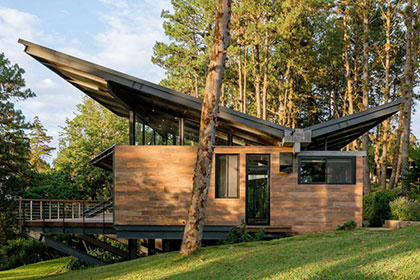
The butterfly roof is a very distinct design associated with contemporary and modern homes. The design is essentially the reverse of the gable design, where the two eaves of the roof are higher than the middle of the roof. Beyond the distinct design of the roof, the main advantage of a butterfly roof is that it clearly directs the water flow to a designated region that is then channeled into a gutter and drain network. This design reduces the likelihood of leaks and potential mold and mildew growth where water would otherwise penetrate. The higher eaves can also increase overall building space, whether in an upper-level loft or attic.
Combination Roof
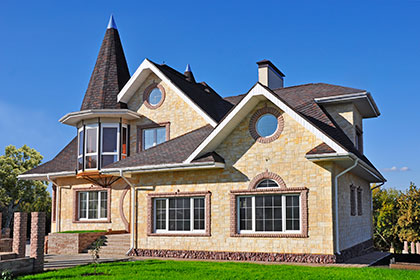
A combination roof is just the way it sounds: a combination of different roofing styles within one roof. For example, a gabled roof that extends over a porch or entranceway could be combined with a hip roof over the rest of the home, or a rounded roof could be combined with a gabled roof. The main advantage of this roof is that it diversifies the overall roof aesthetic while also incorporating more functionality in the living spaces incorporated under one roof. Given the intricacies of combining different roofing styles, a combination roof can be somewhat harder to install.
Making the most of your roof
Whether you are a designer, builder or homeowner, understanding how your roof functions or what to look for in a quality roof can help to make the most of the building and homeowning experience. With so many house roof types ranging from the modern and sophisticated to the common and simple, there are a variety of options to choose from and many advantages and disadvantages to weigh for each one. Fortunately, regardless of the roof already over your head or the one you wish to have, TECHNONICOL roofing shingles can help to make sure that your roof always keeps your home happy and healthy.
Back to blog list